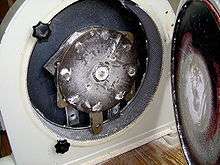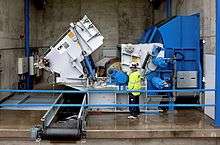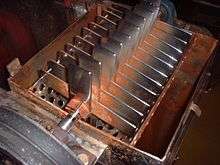Hammermill

A hammermill is a mill whose purpose is to shred or crush aggregate material into smaller pieces by the repeated blows of little hammers. These machines have many sorts of applications in many industries, including:
- Ethanol plants (grains)
- A farm machine, which mills grain into coarse flour to be fed to livestock
- Fluff pulp defiberizing
- Fruit juice production
- Grinding used shipping pallets for mulch
- Milling grain
- Sawmills, size reduction of trim scrap and planer shavings into boiler fuel or mulch

- Shredding paper
- Shredding scrap automobiles (see automotive shredder residue)
- Shredding yard and garden waste for composting
- Crushing large rocks
- In waste management


Operation
The basic principle is straightforward. A hammermill is essentially a steel drum containing a vertical or horizontal rotating shaft or drum on which hammers are mounted. The hammers are free to swing on the ends of the cross, or fixed to the central rotor. The rotor is spun at a high speed inside the drum while material is fed into a feed hopper. The material is impacted by the hammer bars and is thereby shredded and expelled through screens in the drum of a selected size.

The hammermill can be used as a primary, secondary, or tertiary crusher.
Small grain hammermills can be operated on household current. Large hammer mills used in automobile shredders may be driven by diesel or electric motors ranging from 2000 to over 5000 horsepower (1.5 - 3.7MW).
The screenless hammer mill uses air flow to separate small particles from larger ones. It is designed to be more reliable, and is also claimed to be much cheaper and more energy efficient than regular hammermills. The design & structure of the hammermill is always determined by the end use.
History
Invention, involved conversion of rotary water wheel energy to linear trip hammer energy, around Zhao dynasty period of 4 th century in China. [1]
See also
- Blade grinder
- Trip hammer, which may be housed in a mill usually known as a forge, but which was historically occasionally described as a "hammermill".
References
- ↑ Yongxiang Lu, A History of Chinese Science and Technology 2014